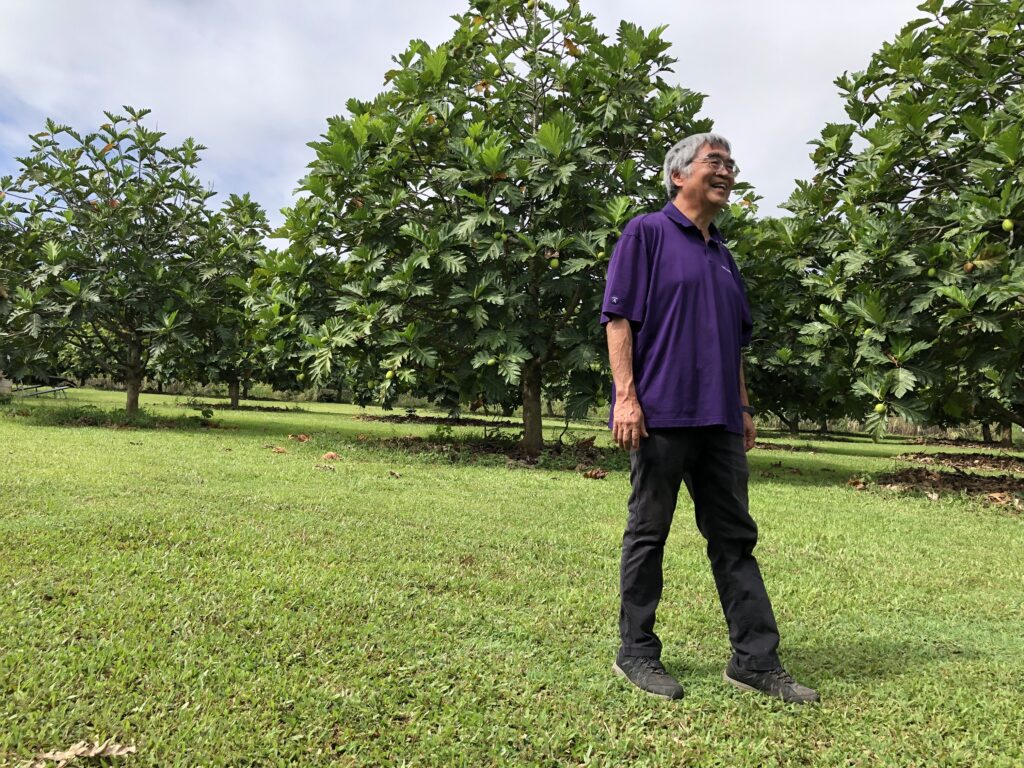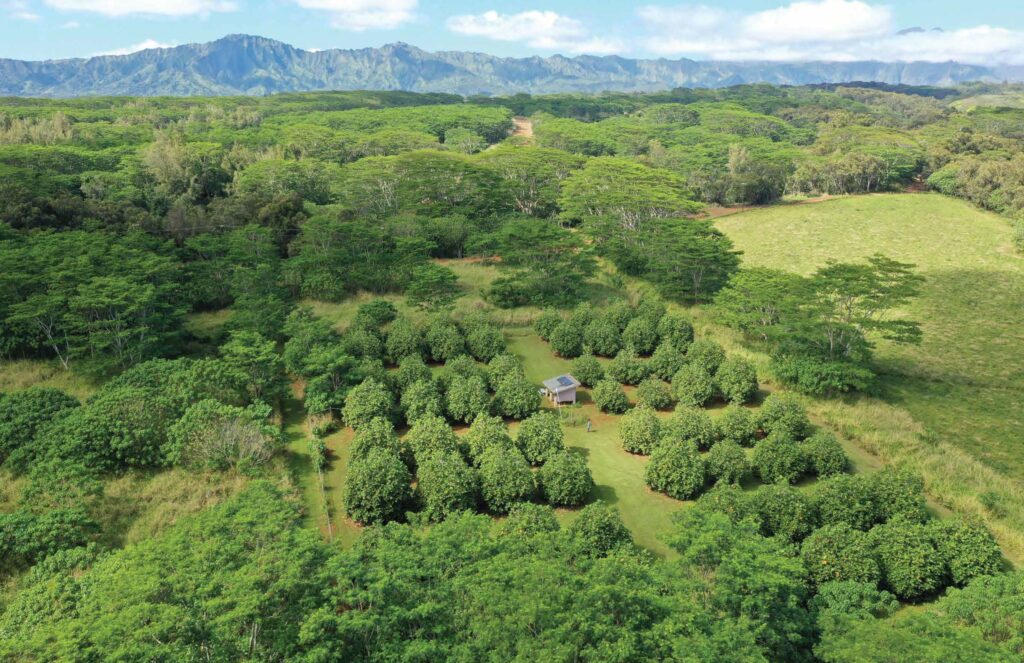By Jon Letman, Editor
Since its establishment in 2003, the mission of NTBG’s Breadfruit Institute (BFI) has been “to promote the conservation, study, and use of breadfruit for food and reforestation.” Among its chief goals has been to encourage the use and understanding of breadfruit — called ʻulu in Hawaiian — so that it can best achieve its potential.
Today that goal is being realized through Ulutopia, a project run by the staff and faculty of Kaua‘i Community College (KCC). The project is centered around a three-acre plot of land divided into four quadrants, each with sixteen breadfruit trees. Since the trees were planted in 2016, Ulutopia has proven to be a popular outdoor classroom for local students and visiting researchers, as well as a source of abundant, nutritious food that is feeding the community.
(L) ʻUlu fruit. (R) Brian Yamamoto standing alongside ʻulu trees in Ulutopia.
Ulutopia’s genesis involved Breadfruit Institute director emeritus Dr. Diane Ragone and KCC faculty Brian Yamamoto and Sharad Marahatta sketching out ideas on a whiteboard with input from experimental design by BFI partner Dr. Susan Murch of the University of British Columbia – Okanagan. Brian, the project faculty lead and a professor of botany and microbiology, encouraged Sharad to develop the plan who came up with the name. Together they purchased a box of 64 tissue cultured five-gallon treelets — all Ma’afala — a Samoan variety which had been selected and carefully developed for mass distribution after years of research by Diane, Susan, and others.
Planted neatly in rows in what had previously been weedy, fallow land once used for growing sugarcane, rainfall and hand-trucked water provides are the site’s only irrigation. Walking between the leafy trees, Brian describes the value of the project for visiting researchers.
“There’s a group from New York running microbiological studies of the material under the mulch looking at carbon sequestration,” he says, mopping his brow on a muggy autumn morning.
A group of students from a technical college visiting from Japan used the site to practice measuring moisture content, temperature, and other indicators using ground sensors. Other researchers from the University of Hawaiʻi collected leaf samples to measure the impact of fertilization practices.
One observation confirmed by measuring nutrient levels in soil and water, Brian says, is that because Ulutopia was planted on a slight grade, fertilizer and water flowing down slope have produced larger yields and larger trees than those growing up slope. With fertilization, Brian adds, the fruiting cycle has been extended to nearly year-round production.

With such high yields, and because Ulutopia is supported by a federal grant, Brian explains that KCC donates all its harvests, supplying thousands of pounds of breadfruit to the Food Bank of Hawaiʻi, school cafeterias, and Kauaʻi’s primary hospital for use in its dining facilities. Previously the hospital purchased and imported frozen breadfruit from Hawaiʻi Island, but now serves breadfruit harvested just a few miles away. KCC also uses young breadfruit trees that rise from spreading root suckers for an annual community tree giveaway.
Ulutopia’s fruit is used for value-added projects including one that uses a commercial drier and grinder to make ʻulu flour, enabling the college to provide free flour to local bakers and KCC’s culinary program so they can experiment and gain proficiency before purchasing ʻulu flour in the commercial marketplace.
Kauaʻi entrepreneur Dominque Chambers, owner of Cozy Bowl, a company specializing in breadfruit pasta (ʻulu campanelle, fusilli, rigatoni, etc.) relies on local ʻulu production, so when Ulutopia donated some 800 pounds of its fruit last autumn, she dehydrated what she could for flour, freezing the rest. Dominique, who has enthusiastically volunteered at NTBG, donates her time and sells a portion of her pasta at very low cost to support Nourish Kauai, a small Kauaʻi non-profit organization which provides chef-curated meal kits (more than 77,000 meals) to qualifying kupuna (grandparents/elders) in need.
Dominique, an ardent ʻulu advocate, is a model of what the prioritization of breadfruit looks like. She says Ulutopia is “really powerful in terms of getting young people to become emotionally invested in farming ʻulu.” With a growing need to bolster food security in Pacific Island nations, she sees limitless potential in helping small and vulnerable communities.

Photo by David Bryant
Meanwhile, Ulutopia serves as a learning space for Kauaʻi youth. Trineen Lopes Lacaden and Shannon Pabo, instructors with KCCs Cognition Learning Center (“Cogs”), regularly introduce young students to botanical, horticultural, and other STEM subjects at Ulutopia where K-12 students learn to take measurements, collect data, and other horticulture an agriculture basics. Ulutopia also gives students from Hawaiian language charter schools the opportunity to interact with an important heritage crop.
Trineen says the most popular lessons revolve around eating, noting that students pay closest attention when they are active and touching the fruit, adding, “it’s tangible and they’re in the field, it just makes more sense and they’re more excited.”
Asked if Ulutopia would exist without the Breadfruit Institute, Brian answers emphatically: “No. Easily no. The only reason this came about was my connection to NTBG.” From its importance as a place for research and teaching, to the cultural knowledge perpetuated and vital food being provided to the community, Ulutopia offers a template that others can model and replicate in a space as small as half an acre.
After NTBG’s Mariella Mladineo, an agroforestry technician with the Breadfruit Institute, was given a tour of Ulutopia, she says it increased her appreciation of how the common goal of elevating breadfruit’s prominence can be achieved in many different ways. While Ulutopia’s approach differs from the BFI, the end goals are very similar. “At the Breadfruit Institute, we look forward to future collaborations with programs such as Ulutopia,” Mariella says, “to learn from each other and build on our shared knowledge.”
Plants nourish our ecosystems and communities in countless ways. When we care for plants, they continue caring for us. Help us grow a brighter tomorrow for tropical plants.